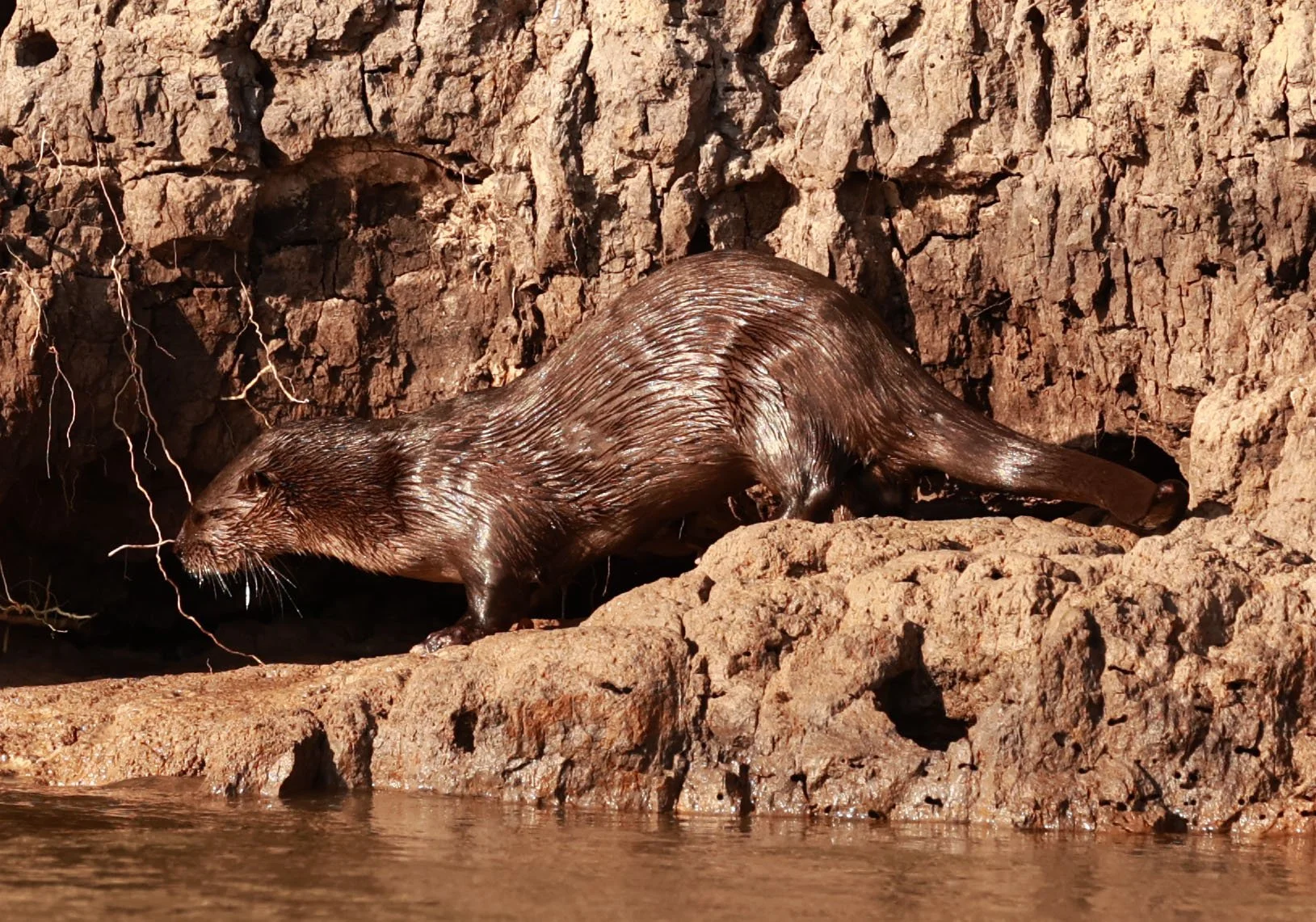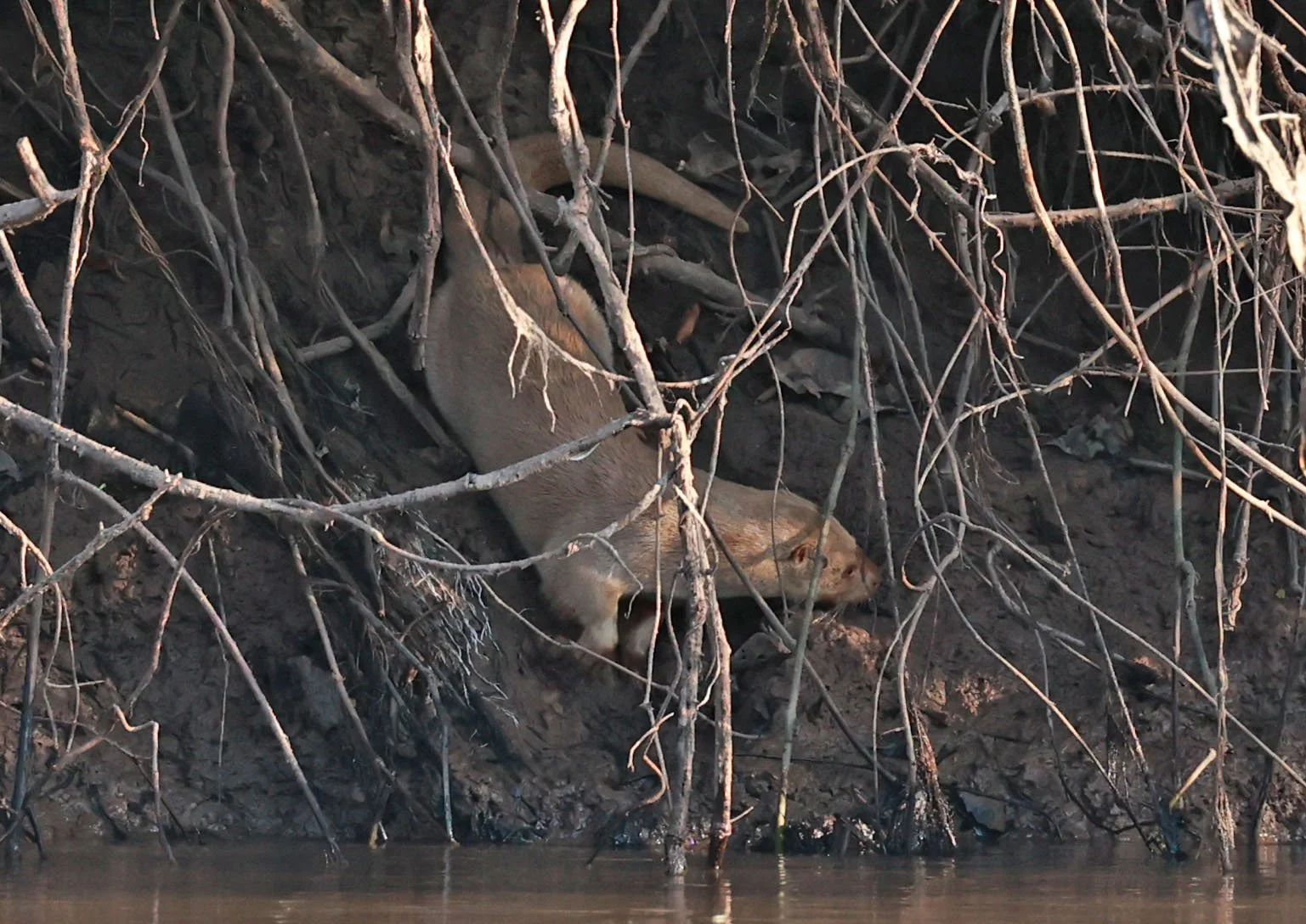
Neotropical River Otter (Lontra longicaudis)
The Neotropical otter or Neotropical River Otter (Lontra longicaudis) is an otter species found in Mexico, Central America, South America, and the island of Trinidad. It is physically similar to the northern and southern river otter, which occur directly north and south of this species' range. Its head-and-body length can range from 36–66 centimetres (14–26 in), plus a tail of 37–84 centimetres (15–33 in). Body weight ranges from 5–15 kilograms (11–33 lb). Otters are members of the family Mustelidae, the most species-rich (and therefore diverse) family in the order Carnivora.
This otter is found in many different riverine habitats, including deciduous and evergreen forests, savannas, llanos and pantanal. It prefers to live in clear fast-flowing rivers and streams. It is a relatively solitary animal and feeds mostly on fish and crustaceans.
The taxonomy of the genus Lontra has been debated, but the use of Lontra rather than Lutra for New World otters is generally supported. The Neotropical otter has a very wide range, covering a large portion of South America, so it is not surprising there are geographical structures separating some populations. One such geographical isolation is the Cordillera Mountains. Additionally, the river in the Magdellena river valley flows north, away from the mountains, decreasing the likelihood that otters in the northern tip of South America will mix with otters elsewhere in the continent.
Neotropical otters have an unusual phylogenic relationship to other otter species. They are most similar to marine otter (Lontra felina) and southern river otter (Lontra provocax), which is not surprising considering these two species are found in South America. However, Neotropical otters are relatively distantly related to giant otter (Pteronura brasiliensis), which is surprising considering they have nearly identical ecological niches and home ranges.
A leucistic Neotropical River Otter in the Southern Pantanal, Aguape.
In one study, otters within a 1,600 square mile area in southern Brazil showed low nucleotide variation, but high haplotype diversity compared to other otter species and other carnivores. The study made the conclusion that otters may be undergoing a recent increase in diversity. The results also show interrelatedness of otters nearby and give reason to separate the species into subspecies:
Lontra longicaudis annectens
Lontra longicaudis colombiana
Lontra longicaudis enudris
Lontra longicaudis incarum
Lontra longicaudis longicaudis
Lontra longicaudis raferrous
The Neotropical otter is covered in a short, dark grayish-brown pelage. Fur color is lighter around the muzzle and throat. They possess a long wide tail, with short stout legs and fully webbed toes. Sexually dimorphic, the males are about 25% larger than the females. Its head-and-body length can range from 36–66 centimetres (14–26 in), plus a tail of 37–84 centimetres (15–33 in). Body mass of the otter generally ranges from 5 to 15 kilograms (11-33 pounds). Neotropical otters will communicate with nearby otters via scent marking. Communication may also occur via whistles, hums, and screeches.
The Neotropical otter has the widest distribution of all the Lontra species. Their habitat can range from northwest Mexico to central Argentina. They prefer clear, fast-flowing rivers, and are rarely known to settle in sluggish, silt-laden lowland waters or boggy areas. While mostly occurring at 300 to 1500 m above sea level, they have been found settled at 3000 m. They require dense riparian vegetation and abundant den sites but, other than that, the Neotropical otter is very versatile and tolerant to environmental change. The otters prefer den sites that are solid, high, dry, and in proximity to deep water.[11] The Neotropical otter is the greatest generalist of all otter species. In addition to rivers and streams, they can settle in and exploit some rather formidable habitats, such as wastewater treatment plants, rice paddies, sugar cane plantations, estuaries, deltas, drainage ditches, and sometimes swamps. They can inhabit cold, glacial lakes and streams in the Andes of Ecuador and Colombia. Neotropical otters will also venture to the seashore and beaches (maintaining an almost "brackish" lifestyle), hunting marine creatures and playing in the highly saline water.
Note the massive wound on this Neotropical River Otter in the Northern Pantanal.
The Neotropical otter's diet consists mostly of fish and crustaceans making up 67% and 28%, respectively, of its total diet. The otter will also occasionally feed on mollusks and small mammals, as well as birds, large insects and fruits. This otter is known to occasionally attack fishnets for a source of prey, hindering fishing productivity. Otters living near marine habitats can have a much higher proportion of crustaceans in their diets.
Seasonality also greatly affect otters' food choice. During the dry season, when less fish and crustaceans are available, one study found a higher proportion of frogs in otters' diet. Though, during this time, anurans and reptiles still made up a very small percentage of the total diet. This might also be due to the fact that certain frogs mate during the dry season, so the frogs are easier prey. All in all, the distribution of available food species in a particular area roughly correlates to the percentage of each species found in otters' diet.
Like other otter species, Neotropical otters will mark their territory with scratching or spraint (feces) in obvious places like rocks and under bridges. Signs of marking may be most concentrated around their dens. They tend to only mark in certain areas of the den, separate from the activity center of the den. In caves, where a water sources may leak through the walls and wash away the scent, the resident may mark areas inside their den.
The niches and ranges of the giant otter and the Neotropical otter overlap widely. Both species are diurnal and mainly piscivorous. The giant otter is less of a generalist in habitat, preferring slow-moving water and overhanging vegetation, but where the Neotropical otter may also occur. The giant otter is much larger and hunts in groups, so it can take larger prey. Some areas, like the Pantanal, have high enough productivity such that both otter species can coexist with little or no competition (niche partitioning). Additionally, Neotropical otters prefer deeper and wider streams than giant otters.
The Neotropical otter is listed as Near Threatened by the IUCN. The species is currently protected in Argentina and many other South American countries. Heavy hunting for its fur in the 1950s–1970s resulted in much local extinction over the otter's range. Illegal hunting, habitat destruction through mining and ranching, and water pollution still affect the population of the Neotropical otter. Although there have been attempts at captive breeding, these attempts have been largely unsuccessful.
Neotropical River Otter
Most negative feelings about otters arise from fishermen who compete with the otter for fish. More data is needed to determine how much overlap exists between the fishermen's desired catch and the otter's diet. The highest competition between Neotropical otters and fishermen occurs during drought conditions. Fishermen may move out of their regular fishing areas, into deeper pools where the otter usually hunts in the absence of people. In a study on local fishermen's attitudes, the study revealed that fishermen's knowledge aligned with scientific data about the Neotropical otter's behavior, body description, and other data. Because the fishermen's facts aligned with scientific knowledge, scientists could then trust the fishermen's first-hand accounts about problems they experience with otters. Fishermen reported that otters will damage their fishing gear, but do not damage crab and shrimp nets. The locals have varying opinions about the otters' presence, from understanding they have to share space with the otters to wanting to kill the otters. There have been proposals to subsidize their fish profits lost to otters. However, it might be more beneficial to pay them to collect data on the species. This would benefit fishermen economically, improve fishermen's attitude towards them, and build on to currently insufficient data about this species. Otters are rarely get caught in gillnets, and when they do they very rarely die.
Neotropical otters are threatened by habitat degradation associated with: agriculture, soil compaction, pollution, roadways, and runoff. Also, when forests are cleared for cattle grazing, heavy vegetation (which is the otter's preferred habitat) near streams is also cleared or trampled by cattle. This species is a very important ecological indicator because they prefer ecologically rich, aquatic habitats and have a low reproductive potential.
The below gallery is of an individual photographed in Encontro das Aguas State Park in the Northern Pantanal.













































































The below gallery is of a leucistic individual photographed in Pousada Aguape, in Southern Pantanal.


















































